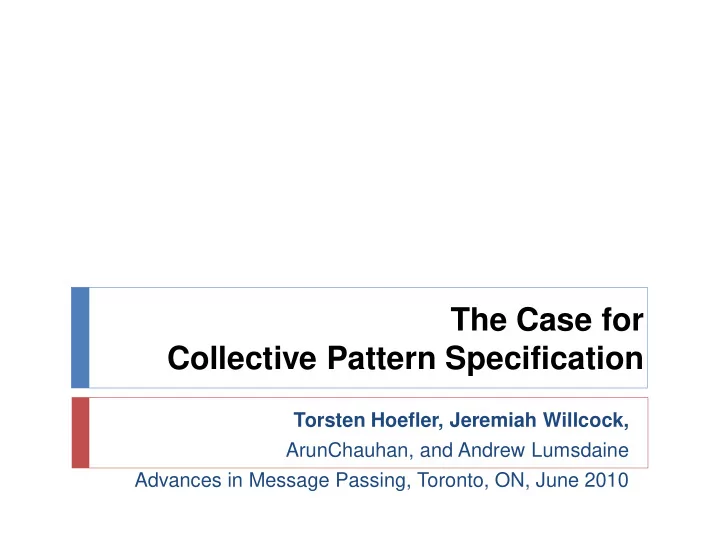

The Case for Collective Pattern Specification Torsten Hoefler, Jeremiah Willcock, ArunChauhan, and Andrew Lumsdaine Advances in Message Passing, Toronto, ON, June 2010
Motivation and Main Theses Message Passing (MP) is a useful programming concept Reasoning is simple and (often) deterministic Message Passing Interface (MPI) is a proven interface definition MPI often cited as “assembly language of parallel computing” Not quite true as MPI offers collective communication But: Many relevant patterns are not covered e.g., nearest neighbor halo exchange Bulk Synchronous Parallelism is a useful programming model for MP programs Easy to reason about the state of the program cf. structured programming vs. goto Torsten Hoefler and Jeremiah Willcock
Valiant’s BSP Model Envisioned as hardware and software model SPMD program execution is split into k supersteps All instances are in the same superstep Implies synchronization / synchronous execution Messages can be sent and received during superstep i Received messages can be accessed in superstep i + 1 Our claim: Many algorithm communication patterns are constant or exhibit temporal locality Should be defined as such! Allows various optimizations Takes the MPI abstractions to a new (higher) level Torsten Hoefler and Jeremiah Willcock
Classification of Communication Patterns We classify applications (or algorithms) into five main classes of communication patterns Compile-time static 1. Run-time static 2. Run-time flexible 3. Dynamic 4. (Massively parallel) 5. Mostly for completeness and not discussed further Torsten Hoefler and Jeremiah Willcock
Compile-time static Communication pattern is completely described in source code Shape is independent of all input parameters Implementation in MPI Either collectives or bunch of send/recvs Proposal for “Sparse collectives” allows definition of arbitrary collectives (MPI 3?) Examples: MIMD Lattice Computation (MILC) – 4d grid Weather Research and Forecasting (WRF) – 2d grid ABINIT – collectives only (Alltoall for 3d FFT) Torsten Hoefler and Jeremiah Willcock
Run-time static Communication pattern depends on input but is fixed during execution Can be compiled once at the beginning Implementation in MPI Use graph partitioner (ParMetis , Scotch, …) Send/recv communication for halo zones Will be supported by “Sparse Collectives” Examples: TDDFT/Octopus – finite difference stencil on real domain Cactus framework MTL-4 (sparse matrix computations) Torsten Hoefler and Jeremiah Willcock
Run-time flexible Communication pattern depends on input but changes over time However, there is still some locality Implementation in MPI Graph partitioning and load balancing Typically send/recv communication (often request/reply) Static optimization might be of little help if pattern changes too frequently Examples: Enzo – cosmology simulation - 3d AMR Cactus framework - Berger-Oliger AMR Torsten Hoefler and Jeremiah Willcock
Dynamic Communication pattern only depends on input and has no locality Little can be done: BSP might not be the ideal model Implementation in MPI: Typically send/recv request/reply Active message style Often employ “manual” termination detection with collectives (Allreduce) Not a good fit to MPI 2.2 (MPI 3?) Examples: Parallel Boost Graph Library (PBGL) – implements various graph algorithms on distributed memory Torsten Hoefler and Jeremiah Willcock
Our Proposal Specify collective operations explicitly MPI has collectives … but they are inadequate Want to express sparse collectives easily A declarative approach to specifying communication patterns Describe the what , not the how , of communications An abstract specification that is implemented efficiently Don’t talk about individual messages Torsten Hoefler and Jeremiah Willcock
Benefits Abstract specification Easier for programmers to understand Easier for compilers to optimize Overlap communication and computation Message coalescing, pipelining, etc. Does not need to be implemented as BSP (weak sync.) An efficient runtime That can choose an implementation approach based on memory/network tradeoffs Use one-sided or two-sided based on hardware Torsten Hoefler and Jeremiah Willcock
Compile-time static Communication patterns expressed as a set of individual communication operations Built by quantifying over processors, array rows, etc. Dense and sparse collectives are supported directly Compiler optimizations apply readily for all nodes p in grid: send A[0] on p to B[n] on up(p) and A[n] on p to B[0] on down(p) Torsten Hoefler and Jeremiah Willcock
Run-time static and flexible Collective communication pattern can be generated at run-time, and regenerated as necessary Communication operations can use array references, etc. Compiler analyses are more difficult in these cases Run-time optimization must sometimes be used Communication patterns may not be known globally Not scalable for large systems Conversion to multicast/… trees may be impossible for all nodes p in grid: send A[0] on p to B[n] on next[p] Torsten Hoefler and Jeremiah Willcock
Summary Communications in BSP-style programs should be expressed as collective operations We suggest using a declarative specification of the communication operations Better ease of development Enables compiler optimizations (e.g., removing strict synchronization) Our approach can be embedded into an existing programming language as a library Can be added incrementally to existing applications Torsten Hoefler and Jeremiah Willcock
Thank you for your attention! Discussion Torsten Hoefler and Jeremiah Willcock
Recommend
More recommend